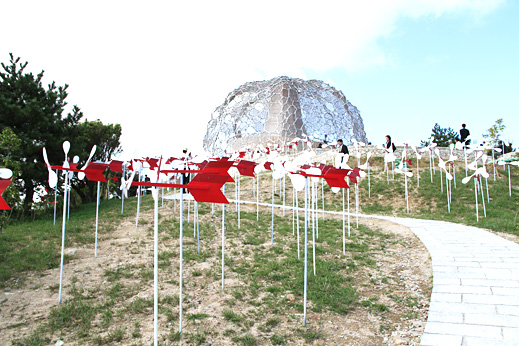 |
Focus features two in-depth reviews each month of fine art, architecture and design exhibitions and events at art museums, galleries and alternative spaces around Japan. The contributors are non-Japanese art critics living in Japan. |
|
|
 |
 |
 |
Art on the Mount
Christopher Stephens |
 |
 |
| Ryutaro Fujie's Red or White on the hill below Hiroshi Sambuichi's Rokko Shidare |
In the manner of many recent festivals, "Rokko Meets Art" (running through Nov. 23) is a playful affair that encourages an appreciation of both artistic creation and natural beauty. Consisting primarily of interactive and site-specific works, some of which are concealed in a grove of trees or beside a pond, the exhibition is concentrated around four main outdoor areas located from three to 18 minutes' walking distance of each other. The mountaintop site promises a respite from urban life without being overly remote, and though on weekends the event is likely to be crowded, those in search of solitude can expect a quieter experience during the week.
Popular with hikers and skiers, Mt. Rokko, the collective name for the range of mountains that towers over Kobe in southeastern Hyogo Prefecture, is home to Japan's first golf course (opened in 1903) and renowned for its dazzling night view (said to be worth "10 million dollars"). But even in the light of day the expanse of Osaka Bay, stretching from Wakayama to the Akashi-Kaikyo Bridge, is an impressive sight. To get their bearings, visitors to "Rokko Meets Art" would do well to begin their tour at Rokko Shidare, a recently completed observation point at the heart of the exhibition. Designed by Hiroshima-based architect Hiroshi Sambuichi, whose past works include the renovation of a former copper smelting plant on the Seto Inland Sea island of Inujima, the structure makes use of natural energy sources like ice, wind, and sunlight for cooling and heating. Shaped something like a bundt pan enclosed in the jagged skeleton of a geodesic dome, the wooden building contains a sitting area that affords a view of the sky through a large opening in the ceiling.
Covering the hill around Rokko Shidare is Ryutaro Fujie's Red or White, an installation of arrow-shaped propellers that spin and change direction with the wind, sometimes appearing to be completely red, other times white. Inspired by the sight of wind turbines in Germany, where the artist currently lives, Fujie's work sets the tone for the event with its simple yet compelling design and integration of local climatic conditions. It's no surprise, then, that Red or White was singled out of the 20 works chosen from public submissions to receive the festival's grand prize (worth ¥1 million).
In addition, 21 other individuals or groups were specially invited to show in the event. Among these is Yukio Fujimoto, known for his sound-related installations, whose contribution here is a bench tucked away in a clearing in the forest with the permutation "silent/listen" spelled out in holes set deep inside its thick transparent seat. Titled apollon's forest, the work is a kind of companion piece to John Cage's 4'33", inviting the visitor to pick out elements of the aural environment and actively participate in the act of listening.
Long associated with the music box, which he has modified and updated for the contemporary era, Fujimoto's influence is also apparent in works like Makiko Masuda's large, hand-driven music box with a carved log as a cylinder and wooden blocks for teeth, and the male-female duo Kosuge1-16's music-box-shaped tennis court roller titled Stripes, which plays the Hanshin Tigers theme song "Rokko Oroshi" (The Wind of Mt. Rokko) when pulled at the correct speed. (A few other such works can be found in one of the mountain's regular tourist attractions, a museum of music boxes and other automatic instruments called Hall of Halls.)
 |
|
 |
| Yukio Fujimoto, apollon's forest |
|
Kosuge1-16, Stripes |
There are several house-style installations spread over the site that are sporadically occupied by their creators. Among these are the temporary quarters of Ryo Kaneko (also known as Nobi-aniki for his predilection for dressing like the Nobi Nobita character in Doraemon), where he is given to playing with mud amid regular household furnishings; Saburo Ota's greenhouse, filled with personal heirlooms and various seed- and plant-related works; and the architect Mikiko Endo's Yagi House Project, a group of wooden, goat-shaped structures that are part of a larger effort to provide assistance to HIV-positive mothers in Africa.
"Rokko Meets Art" is the kind of festival where one tends to walk by a work without noticing it. There are no arrows or recorded messages exhorting the visitor down any particular path -- getting lost and stumbling on something unexpected is all part of the plan. As a result, the works on display tend toward the subtle and subdued. But as Koji Kakuno -- who has set himself the task of remaining suspended from a tree branch disguised as a bagmoth while tweeting on his iPhone for the entire event -- would surely agree, it's a great place to hang around.
 |
|
 |
| Mikiko Endo, Yagi House Project |
|
Koji Kakuno, Minomushinau
All photos by Megumi Nohara; images © Hanshin Leisure Facilities Co., Ltd.
|
|
 |
 |
Christopher Stephens
Christopher Stephens has lived in the Kansai region for close to 25 years. In addition to serving as the editor of the now defunct magazine Kansai Time Out for many years, he has extensive experience as the translator of numerous exhibition catalogues for museums throughout Japan, and art and architecture books such as What's Gutai?, The Architecture of E.G. Asplund: 1885-1940, Salon to Biennial, World Architects 51, Miwa Yanagi: Windswept Women, Tomoko Konoike's Inter-Traveller, and Tadanori Yokoo's Tokyo Y-Junctions. |
|
 |
|